(完整word版)六年级英语语法知识点名词单复数
- 格式:doc
- 大小:15.94 KB
- 文档页数:3
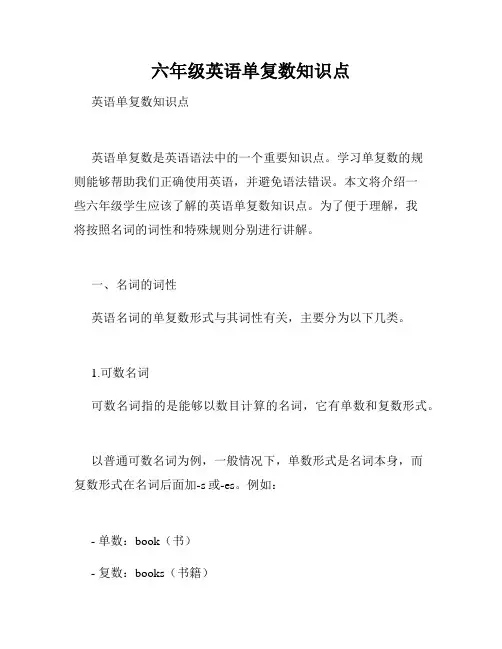
六年级英语单复数知识点英语单复数知识点英语单复数是英语语法中的一个重要知识点。
学习单复数的规则能够帮助我们正确使用英语,并避免语法错误。
本文将介绍一些六年级学生应该了解的英语单复数知识点。
为了便于理解,我将按照名词的词性和特殊规则分别进行讲解。
一、名词的词性英语名词的单复数形式与其词性有关,主要分为以下几类。
1.可数名词可数名词指的是能够以数目计算的名词,它有单数和复数形式。
以普通可数名词为例,一般情况下,单数形式是名词本身,而复数形式在名词后面加-s或-es。
例如:- 单数:book(书)- 复数:books(书籍)当名词以s, sh, ch, x, o结尾时,复数形式要加-es。
例如:- 单数:bus(公交车)- 复数:buses(公共汽车)部分名词复数形式是不规则的,需要具体记忆。
2.不可数名词不可数名词指的是不能以数目计算的名词,它只有单数形式。
不可数名词通常表示某种物质、资格、抽象概念等,例如:- water(水)- sugar(糖)- advice(建议)不可数名词没有复数形式,因此在句子中,谓语动词需使用单数形式。
3.可数/不可数名词有些名词既可以是可数名词,也可以是不可数名词,根据语境的不同而变化。
以tea(茶)为例,当表示一杯茶时,是可数名词;当表示茶的概念或茶叶时,是不可数名词。
二、特殊规则除了基本的名词词性知识,还有一些特殊规则需要注意。
1.以y结尾的名词当名词以辅音字母+y结尾时,将y变为i,再加-es构成复数形式。
例如:- 单数:baby(婴儿)- 复数:babies(婴儿们)2.以f或fe结尾的名词当名词以f或fe结尾时,复数形式通常将f或fe改为v,再加-es或-s。
例如:- 单数:leaf(叶子)- 复数:leaves(叶子们)部分名词的复数形式为不规则,需要具体记忆。
3.以o结尾的名词大部分以o结尾的名词,在复数形式时加-es。
例如:- 单数:tomato(番茄)- 复数:tomatoes(番茄们)但是也有一些例外,如photo(照片)的复数形式是photos。
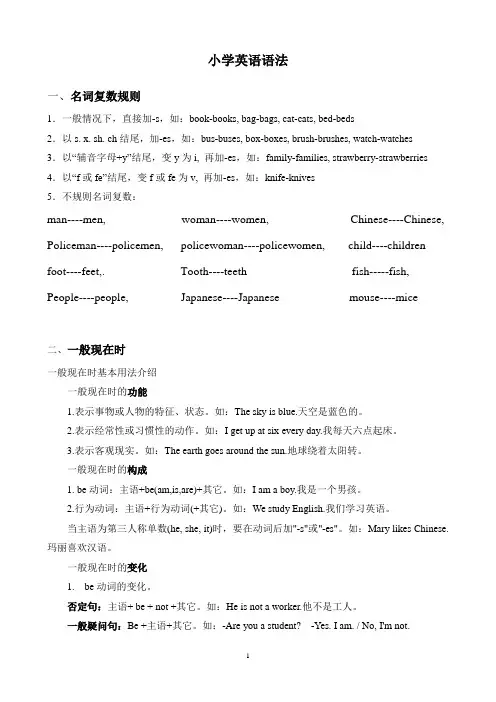
小学英语语法一、名词复数规则1.一般情况下,直接加-s,如:book-books, bag-bags, cat-cats, bed-beds2.以s. x. sh. ch结尾,加-es,如:bus-buses, box-boxes, brush-brushes, watch-watches3.以“辅音字母+y”结尾,变y为i, 再加-es,如:family-families, strawberry-strawberries 4.以“f或fe”结尾,变f或fe为v, 再加-es,如:knife-knives5.不规则名词复数:man----men, woman----women, Chinese----Chinese, Policeman----policemen, policewoman----policewomen, child----children foot----feet,. Tooth----teeth fish-----fish, People----people, Japanese----Japanese mouse----mice二、一般现在时一般现在时基本用法介绍一般现在时的功能1.表示事物或人物的特征、状态。
如:The sky is blue.天空是蓝色的。
2.表示经常性或习惯性的动作。
如:I get up at six every day.我每天六点起床。
3.表示客观现实。
如:The earth goes around the sun.地球绕着太阳转。
一般现在时的构成1. be动词:主语+be(am,is,are)+其它。
如:I am a boy.我是一个男孩。
2.行为动词:主语+行为动词(+其它)。
如:We study English.我们学习英语。
当主语为第三人称单数(he, she, it)时,要在动词后加"-s"或"-es"。
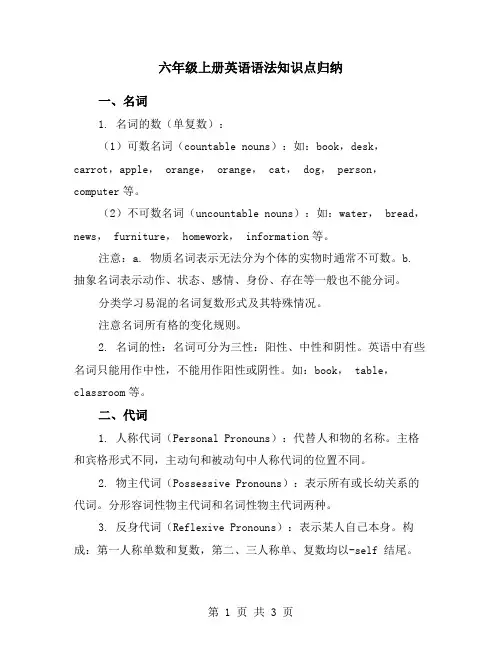
六年级上册英语语法知识点归纳一、名词1. 名词的数(单复数):(1)可数名词(countable nouns):如:book,desk,carrot,apple, orange, orange, cat, dog, person,computer等。
(2)不可数名词(uncountable nouns):如:water, bread,news, furniture, homework, information等。
注意:a. 物质名词表示无法分为个体的实物时通常不可数。
b. 抽象名词表示动作、状态、感情、身份、存在等一般也不能分词。
分类学习易混的名词复数形式及其特殊情况。
注意名词所有格的变化规则。
2. 名词的性:名词可分为三性:阳性、中性和阴性。
英语中有些名词只能用作中性,不能用作阳性或阴性。
如:book, table,classroom等。
二、代词1. 人称代词(Personal Pronouns):代替人和物的名称。
主格和宾格形式不同,主动句和被动句中人称代词的位置不同。
2. 物主代词(Possessive Pronouns):表示所有或长幼关系的代词。
分形容词性物主代词和名词性物主代词两种。
3. 反身代词(Reflexive Pronouns):表示某人自己本身。
构成:第一人称单数和复数,第二、三人称单、复数均以-self 结尾。
4. 相互代词(Mutual Pronouns):表示相互关系的两个事物。
只有“each other”和“one another”两种形式。
5. 指示代词(Demonstrative Pronouns):表示周围的人或事物。
分近指和远指。
近指:this,这些;that,那些。
远指:these,这些;those,那些。
6. 疑问代词(Interrogative Pronouns):用在特殊疑问句中,问人或事物。
who谁,whom哪个(她)人,whose谁的,what什么,which哪个(些)等。
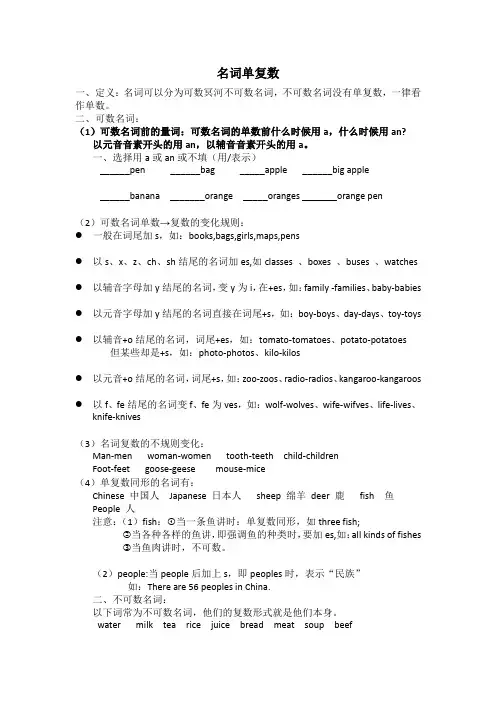
名词单复数一、定义:名词可以分为可数冥河不可数名词,不可数名词没有单复数,一律看作单数。
二、可数名词:(1)可数名词前的量词:可数名词的单数前什么时候用a,什么时候用an?以元音音素开头的用an,以辅音音素开头的用a。
一、选择用a或an或不填(用/表示)______pen ______bag _____apple ______big apple______banana _______orange _____oranges _______orange pen(2)可数名词单数→复数的变化规则:●一般在词尾加s,如:books,bags,girls,maps,pens●以s、x、z、ch、sh结尾的名词加es,如classes 、boxes 、buses 、watches ●以辅音字母加y结尾的名词,变y为i,在+es,如:family -families、baby-babies ●以元音字母加y结尾的名词直接在词尾+s,如:boy-boys、day-days、toy-toys ●以辅音+o结尾的名词,词尾+es,如:tomato-tomatoes、potato-potatoes但某些却是+s,如:photo-photos、kilo-kilos●以元音+o结尾的名词,词尾+s,如:zoo-zoos、radio-radios、kangaroo-kangaroos ●以f、fe结尾的名词变f、fe为ves,如:wolf-wolves、wife-wifves、life-lives、knife-knives(3)名词复数的不规则变化:Man-men woman-women tooth-teeth child-childrenFoot-feet goose-geese mouse-mice(4)单复数同形的名词有:Chinese 中国人Japanese 日本人sheep 绵羊deer 鹿fish 鱼People 人注意:(1)fish:①当一条鱼讲时:单复数同形,如three fish;②当各种各样的鱼讲,即强调鱼的种类时,要加es,如:all kinds of fishes③当鱼肉讲时,不可数。
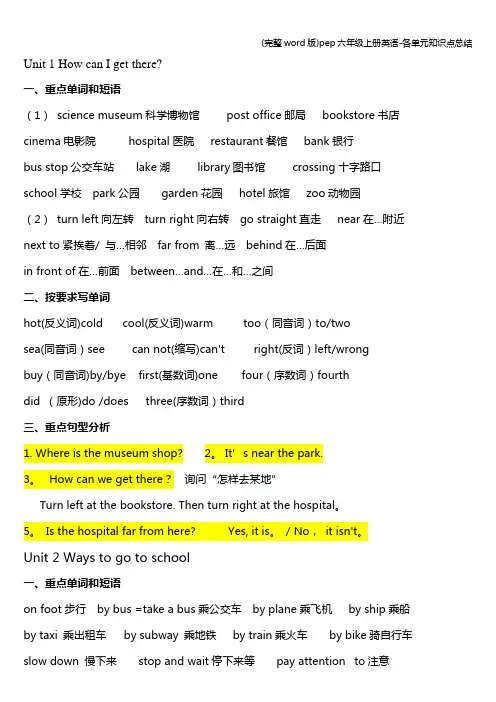
Unit 1 How can I get there?一、重点单词和短语(1)science museum科学博物馆post office邮局bookstore书店cinema电影院hospital医院restaurant餐馆bank银行bus stop公交车站lake湖library图书馆crossing十字路口school学校park公园garden花园hotel旅馆zoo动物园(2)turn left向左转turn right向右转go straight直走near在…附近next to紧挨着/ 与…相邻far from 离…远behind在…后面in front of在…前面between…and…在…和…之间二、按要求写单词hot(反义词)cold cool(反义词)warm too(同音词)to/twosea(同音词)see can not(缩写)can't right(反词)left/wrongbuy(同音词)by/bye first(基数词)one four(序数词)fourthdid (原形)do /does three(序数词)third三、重点句型分析1. Where is the museum shop? 2。
It’s near the park.3。
How can we get there?询问“怎样去某地”Turn left at the bookstore. Then turn right at the hospital。
5。
Is the hospital far from here? Yes, it is。
/ No,it isn't。
Unit 2 Ways to go to school一、重点单词和短语on foot步行by bus =take a bus乘公交车by plane乘飞机by ship乘船by taxi 乘出租车by subway 乘地铁by train乘火车by bike骑自行车slow down 慢下来stop and wait停下来等pay attention to注意cross the road横穿马路traffic light通信号灯at home在家look right向右看look at朝…看play with和…一起玩二、按要求写单词go (反义词)come foot(复数)feet child(复数)childrenearly(反义词)late good(反义词)bad take(反义词)bringslow(反义词)quick/fast go(过去式)went do(过去式)diddo(第三人称单数) does go(第三人称单数)goessame 相同的(反义词)different不同的miss(过去式)missedwrong 错误(反义词)right正确can(否定形式)can’t三、重点句型分析1。
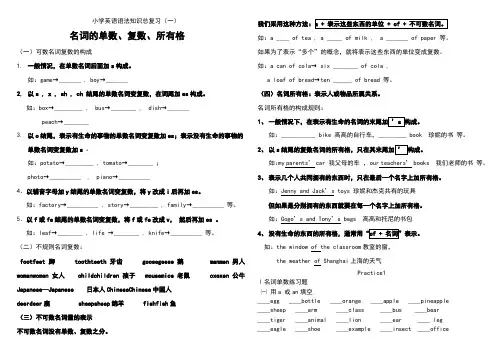
小学英语语法知识总复习(一)名词的单数、复数、所有格(一)可数名词复数的构成1.一般情况,在单数名词后面加s构成。
如:game→_______ , boy→_______2.以s , x , sh , ch 结尾的单数名词变复数,在词尾加es构成。
如:box→_________ , bus→________ , dish→_______peach→________3.以o结尾,表示有生命的事物的单数名词变复数加es;表示没有生命的事物的单数名词变复数加s。
如:potato→_________ , tomato→________ ;photo→__________ , piano→__________4.以辅音字母加y结尾的单数名词变复数,将y改成i后再加es。
如:factory→__________ , story→_________ , family→__________ 等。
5.以f或fe结尾的单数名词变复数,将f或fe改成v,然后再加es 。
如:leaf→________ , life →________ , knife→__________ 等。
(二)不规则名词复数:footfeet脚 toothteeth 牙齿 goosegeese鹅 manmen男人womanwomen女人 childchildren孩子 mousemice老鼠 oxoxen公牛Japanese—Japanese 日本人ChineseChinese中国人deerdeer鹿 sheepsheep绵羊 fishfish鱼(三)不可数名词量的表示不可数名词没有单数、复数之分。
如:a ____ of tea , a _____ of milk , a _______ of paper 等。
如果为了表示“多个”的概念,就将表示这些东西的单位变成复数。
如:a can of cola→ six ________ of cola ,a loaf of bread→ten ______ of bread 等。

完整版)六年级英语语法知识点汇总六年级语法总复一、词汇一)一般过去时态一般过去时态表示在过去的某个时间发生的动作或存在的状态,通常与表示过去的时间状语连用,如yesterday。
last weekend。
last Saturday等。
基本句型为:“主语+动词的过去式+其他”。
例如:“What did you do last weekend?”,“I played football last weekend.”规则动词过去式的构成1.一般在动词原形末尾加-ed,如play—played。
2.词尾是e的动词直接加-d,如dance—danced。
3.末尾只有一个辅音字母的重读闭音节词,先双写这个辅音字母,再加-ed,(停止)ped。
4.结尾是“辅音字母+y”的动词,变“y”为“i”,再加-ed,如study--studied。
一些不规则变化的动词过去式am/is—was,are—were,see—saw,take—took,read—read,sleep(睡觉)—slept,go—went,come—came,swim—swam,fly—flew,e—became,do—did,get—got,have—had,draw—drew,say—said,hurt—hurt,win—won,tell—told,will—would,eat—ate,cut(切)--cut,sit(坐)—sat,think—thought,find—found,make—made,drink—drank,run(跑)—ran,wear—wore,begin(开始)—began,buy—bought,give(给)—gave,sing—sang。
二)一般现在时态一般现在时态表示包括现在时间在内的一段时间内经常发生的动作或存在的状态,表示惯性或客观存在的事实和真理,通常与often。
always。
usually。
sometimes。
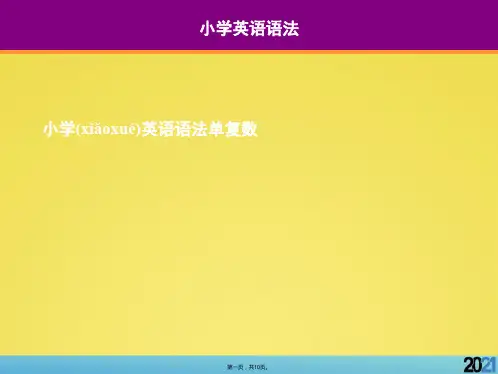
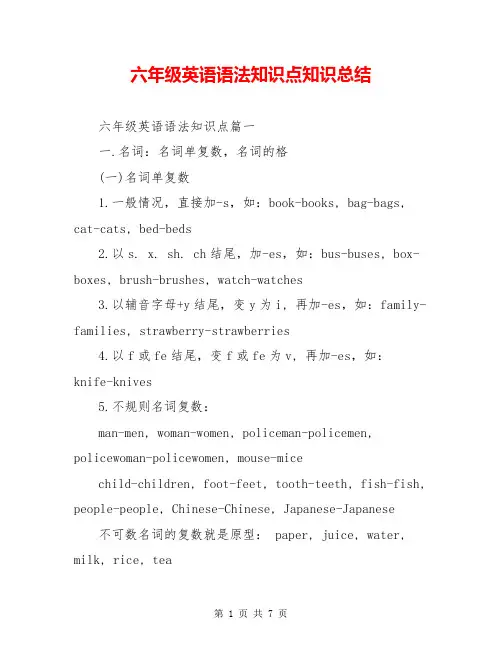
六年级英语语法知识点知识总结六年级英语语法知识点篇一一.名词:名词单复数,名词的格(一)名词单复数1.一般情况,直接加-s,如:book-books, bag-bags, cat-cats, bed-beds2.以s. x. sh. ch结尾,加-es,如:bus-buses, box-boxes, brush-brushes, watch-watches3.以辅音字母+y结尾,变y为i, 再加-es,如:family-families, strawberry-strawberries4.以f或fe结尾,变f或fe为v, 再加-es,如:knife-knives5.不规则名词复数:man-men, woman-women, policeman-policemen, policewoman-policewomen, mouse-micechild-children, foot-feet, tooth-teeth, fish-fish, people-people, Chinese-Chinese, Japanese-Japanese 不可数名词的复数就是原型: paper, juice, water, milk, rice, tea六年级英语语法知识点篇二(一)、形容词的比较级1、形容词比较级在句子中的运用:两个事物或人的比较用比较级,比较级后面一般带有单词than。
比较级前面可以用more, alittle来修饰表示程度。
than后的人称代词用主格(口语中可用宾格)。
2.形容词加er的规则:⑴ 一般在词尾加er ;⑵ 以字母e 结尾,加r ;⑶ 以一个元音字母和一个辅音字母结尾,应双写末尾的辅音字母,再加er ;⑷ 以辅音字母+y结尾,先把y变i,再加er 。
3.不规则形容词比较级:good-better, beautiful-more beautiful(二)副词的比较级1.形容词与副词的区别 (有be用形,有形用be;有动用副,有副用动)⑴在句子中形容词一般处于名词之前或be动词之后⑵副词在句子中最常见的是处于实义动词之后2.副词比较级的变化规则基本与形容词比较级相同 (不规则变化:well-better, far-farther)句法1.陈述句(1)肯定句:是指用肯定的语气来陈述的句子,如:Im a student. She is a doctor. He works in a hospital.There are four fans in our classroom. He will eat lunch at 12:00. I watched TV yesterday evening.(2)、否定句:含有否定词或表示否定意义词的句子,如:Im not a student. She is not (isnt) a doctor.He does not (doesnt) work in a hospital. There are not (arent) four fans in our classroom.He will not (wont) eat lunch at 12:00. I did not (didnt) watch TV yesterday evening.2. 疑问句一般疑问句:是指询问事实的句子,此类句子必须用yes,或no来回答。
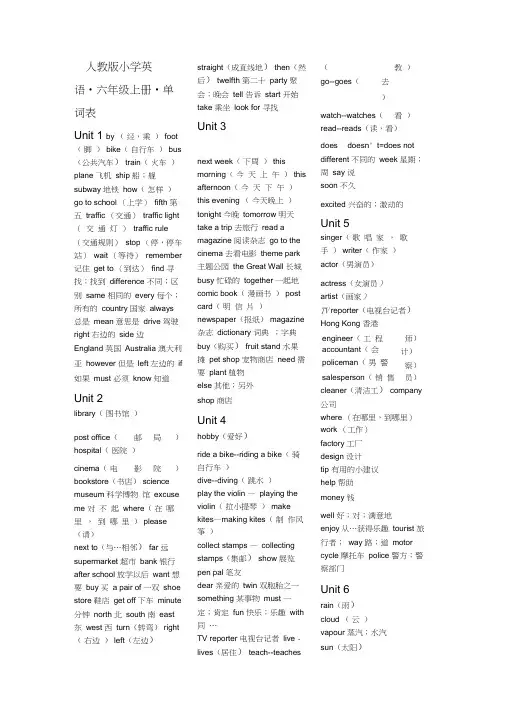
人教版小学英语•六年级上册•单词表Unit 1 by (经,乘) foot (脚) bike(自行车) bus (公共汽车) train(火车)plane 飞机ship 船;舰subway 地铁how(怎样)go to school (上学)fifth 第五traffic (交通)traffic light (交通灯)traffic rule (交通规则)stop (停,停车站)wait (等待)remember 记住get to (到达)find 寻找;找到difference 不同;区别same 相同的every 每个;所有的country 国家always 总是mean 意思是drive 驾驶right 右边的side 边England 英国Australia 澳大利亚however 但是left 左边的if 如果must 必须know 知道Unit 2library(图书馆)post office(邮局)hospital(医院)cinema(电影院)bookstore(书店) science museum 科学博物馆excuse me 对不起where(在哪里,到哪里) please (请)next to(与…相邻) far 远supermarket 超市bank 银行after school 放学以后want 想要buy 买 a pair of 一双shoe store 鞋店get off 下车minute 分钟north 北south 南east 东west 西turn(转弯) right (右边) left(左边)straight(成直线地) then(然后) twelfth 第二十party 聚会;晚会tell 告诉start 开始take 乘坐look for 寻找Unit 3next week(下周) thismorning(今天上午) thisafternoon(今天下午)this evening (今天晚上)tonight 今晚tomorrow 明天take a trip 去旅行read amagazine 阅读杂志go to thecinema 去看电影theme park主题公园the Great Wall 长城busy 忙碌的together 一起地comic book(漫画书) postcard(明信片)newspaper(报纸) magazine杂志dictionary 词典;字典buy(购买) fruit stand 水果摊pet shop 宠物商店need 需要plant 植物else 其他;另外shop 商店Unit 4hobby(爱好)ride a bike--riding a bike(骑自行车)dive--diving(跳水)play the violin —playing theviolin(拉小提琴) makekites—making kites(制作风筝)collect stamps —collectingstamps(集邮) show 展览pen pal 笔友dear 亲爱的twin 双胞胎之一something 某事物must 一定;肯定fun 快乐;乐趣with同…TV reporter 电视台记者live -lives(居住) teach--teaches(教)go--goes(去)watch--watches(看)read--reads(读,看)does doesn' t=does notdifferent 不同的week 星期;周say 说soon 不久excited 兴奋的;激动的Unit 5singer(歌唱家,歌手) writer(作家)actor(男演员)actress(女演员)artist(画家)TV reporter(电视台记者)Hong Kong 香港engineer(工程师)accountant(会计)policeman(男警察)salesperson(销售员)cleaner(清洁工) company公司where (在哪里,到哪里)work (工作)factory 工厂design 设计tip 有用的小建议help 帮助money 钱well 好;对;满意地enjoy从…获得乐趣tourist 旅行者;way 路;道motorcycle 摩托车police 警方;警察部门Unit 6rain(雨)cloud (云)vapour 蒸汽;水汽sun(太阳)stream(河,溪)come from(来自,从…来)shine 照耀become 变成little 小的drop 一滴wake up 醒来feel 感觉到think 想;思考meet 遇见high 高的other 其他的fall 落下down 向下into 进入come out 露出again 又seed (种子) soil(土壤) sprout (苗,芽) plant(植物,种植) should (应该) then (然后) garden 花园easy 简单的put 放several 一些day 天see 看见pot 锅碗瓢盆lovely 可爱的make sure 核实month 月份still 仍然hardly 几乎不人教版小学英语•六年级下册•单词表Unit 1tall —taller 更高的short —shorter 更矮的strong—stronger 更强壮的old —older 年龄更大的young—younger 更年轻的cm(centimeter)厘米than 与… 相比较funnier 更滑稽的big —bigger 更大的heavy —heavier 更重的long —longer 更长的thin —thinner 更瘦的small —smaller (体型)更小feet 脚(复数)size 号码;尺码wear 穿meter 米ton 吨each 各自;每个squid 鱿鱼lobster 龙虾shark 鲨鱼deep 深的seal 海豹sperm whale 抹香鲸killer whale 虎鲸even 甚至Unit 2have a fever 发烧have a sore throat 喉咙疼have a cold 感冒have a toothache 牙疼have a headache 头疼matter 事情,麻烦sore 疼的feel 感觉sick 不舒服的;有病的hurt 疼痛nose 鼻子people 人们flu 流感know 知道might 可以;能worry 烦恼;担忧medicine 药drink 饮料stay 在;逗留better 更好的soon 立刻;不久tired 疲劳的,累的excited 兴奋的angry 生气的happy 高兴的bored 无聊的,烦人的sad 忧伤的,悲伤的trip 旅行fail 不及格;失败test 测试hear 听见match 比赛betwee n 在…之间pass 传递kick 踢a little 有些goal 得分bounce 反弹off 距;离;离开another 另一个guess 猜测win (过去式won )赢game 比赛laugh at 因…而发笑Unit 3 watch—watched 看wash—washed 洗clean—cleaned 打扫play —played 玩visit —visited 看望do—did last weekend 上一个周末go—went 去go to a park —went to a park 去公园go swimming —went swimming 去游泳go fishing —went fishing 去钓鱼read—read 读go hiking —went hiking 去郊游yesterday 昨天study (过去式studied)学习tongue twister 绕口令fiy(过去式flew)飞return 送回;归还swim (过去式swam)游泳Unit 4learn Chinese —learned Chinese 学汉语sing and dance—sang and danced 唱歌和跳舞eat good food —ate good food 吃好吃的食物take pictures—took pictures 照相climb —climbed 爬have—had buy presents—bought presents 买礼物row a boat—rowed a boat 划船see elephant—saw elephant 看大象go skiing —went skiing 去滑雪go ice-skating —went ice-skating 去滑冰how 怎么,如何get—got 到达last 上一个的,仅余的,留在最后的cousin 堂(表)兄弟;堂(表)姐妹relax 放松prepare 准备。
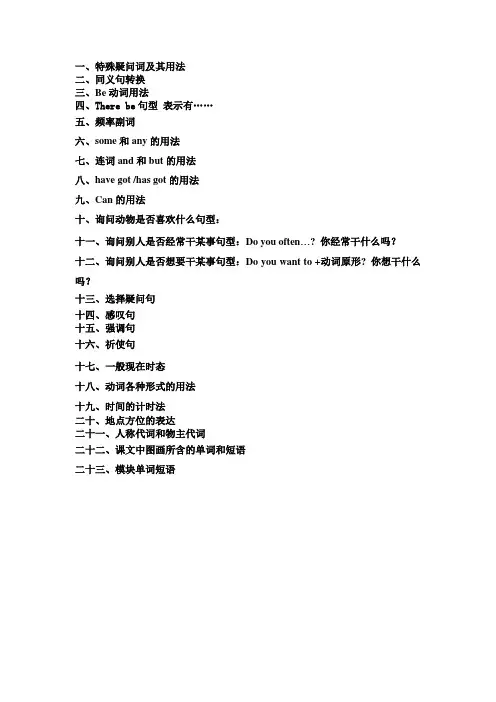
一、特殊疑问词及其用法二、同义句转换三、Be动词用法四、There be句型表示有……五、频率副词六、some和any的用法七、连词and和but的用法八、have got /has got的用法九、Can的用法十、询问动物是否喜欢什么句型:十一、询问别人是否经常干某事句型:Do you often…? 你经常干什么吗?十二、询问别人是否想要干某事句型:Do you want to +动词原形? 你想干什么吗?十三、选择疑问句十四、感叹句十五、强调句十六、祈使句十七、一般现在时态十八、动词各种形式的用法十九、时间的计时法二十、地点方位的表达二十一、人称代词和物主代词二十二、课文中图画所含的单词和短语二十三、模块单词短语一、特殊疑问词及其用法1. How long 问,长度(metre/kilometre)答How long is the Great Wall? It’s about six thousand seven hundred kilometers.2. How big 问,人口(people)答How big is Beijing? Beijing’s got about fourteen million people .3.How many 问,数字+名词复数答。
How many countries are in the UN? 191 countries are in the UN.4. Where问,地点/方向答Where’s New York? It’s in the east of America.5.When 问,时间答When is the UN building open? The UN building is open at 9:45.6.What time 问,钟点答。
What time is it? It’s ten to five.7. What…doing 问,动词ing答What are you doing ? I’m sending an email.8. What(is…的hobby)问,爱好答What is your hobby? Collecting stamps is my hobby./I like collecting stamps.9. What…do问,动词(事情)答。
小学六年级英语语法复习大全汇总一、名词 (1)二、动词 (4)三、一般过去时态 (7)四、一般现在时 (7)五、现在进行时 (8)六、there be 结构 (8)七、形容词及副词的比较级 (8)八、介词 (8)一、名词名词可以分为专有名词(Proper Nouns)和普通名词(Common Nouns),专有名词是某个(些)人,地方,机构等专有的名称,如Beijing,China等。
普通名词是一类人或东西或是一个抽象概念的名词,如:book,sadness等。
普通名词又可分为下面四类:1)个体名词(Individual Nouns):表示某类人或东西中的个体,如:gun。
2)集体名词(Collective Nouns):表示若干个个体组成的集合体,如:family。
3)物质名词(Material Nouns):表示无法分为个体的实物,如:air。
4)抽象名词(Abstract Nouns):表示动作、状态、品质、感情等抽象概念,如:work。
个体名词和集体名词可以用数目来计算,称为可数名词(Countable Nouns),物质名词和抽象名词一般无法用数目计算,称为不可数名词(Uncountable Nouns)1.1 名词复数的规则变化___________________________________________________情况构成方法读音例词__________________________________________________一般情况加-s 1.清辅音后读/s/;map-maps2.浊辅音和元音后bag-bags读/z/;car-cars___________________________________________________以s,sh,ch,x等结尾的词加-es读/iz/bus-buseswatch-watches___________________________________________________以ce,se,ze,(d)ge等结尾的词加-s读/iz/license-licenses___________________________________________________以辅音字母+y变y 为i结尾的词再加es读/z/baby---babies___________________________________________________1.2 其它名词复数的规则变化1) 以y结尾的专有名词,或元音字母+y 结尾的名词变复数时,直接加s变复数:如:two Marys the Henrysmonkey---monkeys holiday---holidays比较:层楼:storey ---storeys story---stories2) 以o 结尾的名词,变复数时:a. 加s,如:photo---photos piano---pianosradio---radios zoo---zoos;b. 加es,如:potato--potatoes tomato--tomatoesc. 均可,如:zero---zeros / zeroes3) 以f或fe 结尾的名词变复数时:a. 加s,如:belief---beliefs roof---roofssafe---safes gulf---gulfs;b. 去f,fe 加ves,如:half---halvesknife---knives leaf---leaves wolf---wolveswife---wives life---lives thief---thieves;c. 均可,如:handkerchief:handkerchiefs / handkerchieves1.3 名词复数的不规则变化1)child---children foot---feet tooth---teethmouse---mice man---men woman---women注意:与man 和woman构成的合成词,其复数形式也是-men 和-women。
小学英语语法:名词一.名词的定义:1.名词分为专有名词和普通名词。
专有名词是表示具体的人、事物、地点、或机构等的专有名称。
如:GuangZhou,Mike,UNESCO等。
专有名词一般情况下第一个字母要大写,前面不加定冠词the。
普通名词是表示一类人、事物或抽象概念的名称。
如:police,eggs,rice等。
普通名词又可分为个体名词、集体名词、物质名词和抽象名词。
个体名词:表示某一类人或某一类东西中的个体。
如:monkey,panda,ruler,boy等。
集体名词:表示一群人或一些事物的总称。
如:family,police,class,people等。
物质名词:表示无法分为个体或不具备确定形状和大小的实物。
如:Water,air,milk等。
抽象名词:表示抽象概念词。
如:hope,love,spirit。
二.可数名词和不可数名词:1.定义:一般来说,个体名词和集体名词多为可数名词,物质名词和抽象名词多为不可数名词。
2.可数名词的数:可数名词有单数、复数之分,表示“一个”时用单数,a bird,a teacher,an apple,表示“多个”时用复数。
two birds,five teachers,eight apples3.可数名词复数的变化规则口诀:名词单数变复数,直接加-s 占多数;s, x, z, ch, sh 来结尾,直接加上-es;词尾是 f 或fe,加-s 之前先变ve;辅母+ y 在词尾,把y 变i 再加-es;词尾字母若是o,常用四个已足够,要加-es 请记好,黑人英雄吃土豆西红柿. A、一般情况下,在单数名词的后面加-s构成。
如:game-games,boy-boys等。
B、以s、x、sh、ch结尾的单数名词变复数,在词尾加-es构成。
如:box-boxes,bus-buses,peach-peaches,dish-dishes。
C、以o结尾,表示有生命的事物的单数名词变复数加-es;口诀:黑人和英雄吃土豆和西红柿+esnegroes and heroes eat tomatoes and potatoes表示没有生命的事物的单数名词变复数加-s。
英语语法六年级基础知识大全一、名词。
1. 名词的概念。
- 名词是表示人、事物、地点、抽象概念等的名称。
例如:boy(男孩),book (书),school(学校),love(爱)。
2. 名词的单复数。
- 一般情况,在名词后加 -s,如:book - books,pen - pens。
- 以s,x,sh,ch结尾的名词,加 -es,如:box - boxes,bus - buses,brush - brushes,watch - watches。
- 以辅音字母 + y结尾的名词,把y变为i,再加 -es,如:baby - babies,city - cities。
- 以f或fe结尾的名词,把f或fe变为v,再加 -es,如:knife - knives,leaf - leaves(但也有一些直接加 -s的,如:roof - roofs)。
- 不规则复数形式,如:man - men,woman - women,child - children,foot - feet,tooth - teeth。
3. 名词所有格。
- 有生命的名词所有格:- 一般在名词后加's,如:the boy's book(男孩的书),Mary's pen(玛丽的钢笔)。
- 如果名词复数是以 -s结尾的,只加',如:the students' classroom(学生们的教室)。
- 无生命的名词所有格:- 常用“of+名词”结构表示,如:the window of the room(房间的窗户)。
二、冠词。
1. 冠词的概念。
- 冠词是一种虚词,放在名词之前,帮助说明名词所指的人或事物。
2. 不定冠词a/an。
- a用于以辅音音素开头的单词前,an用于以元音音素开头的单词前。
例如:a book,an apple。
- 不定冠词表示泛指,指某类人或事物中的一个,如:I have a dog.(我有一只狗。
六年级英语语法点整理1.人称代词主格:I we you she he it they宾格:me us you her him it them形容词性物主代词:my our your her his its their名词性物主代词:mine ours yours hers his its theirs 2.形容词和副词的比较级(1) 一般在形容词或副词后+erolder taller longer stronger, etc(2) 多音节词前+moremore interesting, etc.(3) 双写最后一个字母,再+erbigger fatter, etc.(4) 把y变i,再+erheavier, earlier(5) 不规则变化:well-better, much/many-more, etc.3.可数词的复数形式Most nouns + s a book –booksNouns ending in a consonant +y - y+ ies a story—storiesNouns ending in s, sh, ch or x + es a glass—glasses a watch-watches Nouns ending in o +s or +es a piano—pianos a mango—mangoes Nouns ending in f or fe - f or fe +ves a knife –knives a shelf-shelves 4.不可数名词(单复数形式不变)bread, rice, water ,juice etc.5. 缩略形式I’m = I am you’re = you are she’s = she is he’s = he isit’s = it is who’s =who is can’t =can not isn’t=is not etc6. a/ana book, a peachan egg an hour7. Preposition:on, in ,in front of, between, next to, near, beside, at, behind.表示时间:at six o’clock, at Christmas, at breakfast on Monday on 15th July On National Dayin the evening in December in winter8. 基数词和序数词one –first two-second twenty-twentieth9. Some /anyI have some toys in my bedroom.Do you have any brothers or sisters?10. be 动词(1) Basic form: am/are/is(2) 肯定和否定句I am(not) from London.My eyes are(not) small.My hair is(not) long.(3)一般疑问句:Am I a Chniese? Yes, you are. No, you aren’t. Are they American? Yes, they are. No, they aren’t.Is the cat f at? Yes, it is. No, it isn’t.11. there be 结构肯定句:There is a …There are …一般疑问句:Is there …? Yes, there is./ No, there isn’t.Are there…? Yes, there are. /No, there aren’t.否定句:There isn’t …. There aren’t….12. 祈使句Sit down pleaseDon’t s it down, please.13. 现在进行时.通常用“now”.形式:be + verb +ingeg: I am(not) doing my homework.You/We/They are(not) reading.He/She/It is(not) eating.动词—ing 的形式Most verbs +ing walk—walkingVerbs ending in e -e + ing come—comingShort verbs ending in a vowel + a consonant run –running swim—swimming 14 一般现在时。
格式主格所有格宾格人称我I my me我们we our us你you your you你们you your you他he his him她she her her他们they their them 一、人称代词指示代词分类单数复数近指This( 这个 )These(这些)远指That (那个)Those(那些)二、指示代词三、疑问代词疑问代词用法说明例句who常用于提问人的姓名、身份Who ’s she? what常用于问事物或某人的活动What ’s you father? where常用于问地址,意为“在哪里Where do you live? whose是 who 的所有格形式Whose bike is this?which在必然范围内的特指人活物Which do you like?how常用于问情况“怎么样How tall are you?how many常用于问数量是“多少”How many books are here? how much常用于问价钱是“多少”How much is this bed? How about常用于问别人的感觉“好不好” How about going to school? how old用于问年纪How old is your mother?四、不定代词代替或修代替或修用法说明例句饰可数名饰不可以数词名词some一般用于必然句I have some bookany 一般用于否定句、疑问句I don’t haveany book.Do you have any book?many much 用于修饰表示好多的可数He has much money,but he /不可以数名词doesn’thave many friend.日期英文写法周一Mondy周二Tuesday周三Wednesday周四Thursday周五Friday周六Saturday周日Sunday天day周末weekend教师节Teacher’s Day五、数字和日期一one二two三three四four五five六six七seven八eight九nine十ten十一eleven十二twelve十三thirteen十四fourteen十五fifteen十六sixteen十七seventeen十八eighteen十九nineteen二十twenty 二十一twenty-one 三十thirty三十一thirty-one四十forty五十fifty六十sixty七十seventy八十eighty九十ninety百hundred第一first第二second第三third 各种语法单词齐集元旦New Year国庆节National Day一月Jan./January二月Feb./February三月Mar./March各种语法单词齐集Apr./April四月五月May六月June七月July六、动词三种形态八月Aug./Augest九月Sept./September十月Oct./October十一月Nov./November十二月Dec./December春天Spring夏天Summer秋天Fall冬天Winter动词现在进行时一般现在时 (第三过去式人称单数 )Buy 买buying buys baught Clean 打扫cleaning cleans cleaned Drive 开车driving drives drivedGo 去going goes goneDo 做doing does done Have 有having has had Close 关closing closes closed动词现在进行时(现一般现在时 (第三过去式 (过去分词 )在分词)人称单数 )Open 开opening opens opened Find 搜寻finding finds foundLive 活,住living lives livedRead 阅读reading reads read Swim 游泳swimming swims swam Sing 唱歌singing sings sang Ride 骑车riding rides rode Take 买,带taking takes took Put 放putting puts putStop 停止stpping stops stoped Run 跑步running runs ranWait 等待waiting waits waited Look 看looking looks looked Wash 洗washing washes washed Watch 看(电视)watching watches watched Wear 穿(衣服)wearing wears worn Write 写字writing writes wrote六年级英语语法知识汇总一、词类:1、动词:行为动词、be动词、神情动词。
小学英语语法总结6文档一、名词1.名词的构成:可数名词和不可数名词。
可数名词有单数和复数形式,复数形式通常在名词后面加s或es,也有一些不规则变化的复数形式。
2.名词的用法:可以用来指代人、动物、事物、地方等具体的对象。
二、代词1.人称代词:主格代词和宾格代词;2.物主代词:形容词性物主代词和名词性物主代词;3.指示代词:this、that、these、those;4.反身代词:myself、yourself、himself、herself等。
三、冠词1.定冠词the:用于特指一些人或事物;2.不定冠词a/an:用于泛指一些人或事物。
四、动词1.动词的时态:一般现在时、一般过去时、一般将来时;2.动词的变化形式:第三人称单数形式以s或es结尾;3.动词的用法:可以表示行为、状态、感觉等。
五、形容词和副词1.形容词:可用来修饰名词,通常置于名词前面;2.副词:可用来修饰动词、形容词和其他副词,通常位于词组的最后。
六、介词1.介词的用法:用来表示时间、地点、原因、目的等;2.常见的介词:in、on、at、from、to、for等。
七、连词1.并列连词:用来连接两个并列的词、短语或句子,常见的有and、but、or等;2.从属连词:用来引导从句,常见的有because、if、when等。
八、句子1.陈述句:叙述其中一种事实或情况,语序为主语+谓语;2.疑问句:用来提问,语序为谓语+主语或助动词+主语+谓语。
以上是小学英语语法的一些基础知识总结,涵盖了名词、代词、冠词、动词、形容词和副词、介词、连词以及句子的基本结构和用法。
通过对这些语法知识的掌握,可以更好地理解和运用英语,提升英语水平。
名词单复数
一、定义:名词可以分为可数冥河不可数名词,不可数名词没有单复数,一律看作单数。
二、可数名词:
(1)可数名词前的量词:可数名词的单数前什么时候用a,什么时候用an?
以元音音素开头的用an,以辅音音素开头的用a。
一、选择用a或an或不填(用/表示)
______pen ______bag _____apple ______big apple
______banana _______orange _____oranges _______orange pen
(2)可数名词单数→复数的变化规则:
●一般在词尾加s,如:books,bags,girls,maps,pens
●以s、x、z、ch、sh结尾的名词加es,如classes 、boxes 、buses 、watches ●以辅音字母加y结尾的名词,变y为i,在+es,如:family -families、baby-babies ●以元音字母加y结尾的名词直接在词尾+s,如:boy-boys、day-days、toy-toys ●以辅音+o结尾的名词,词尾+es,如:tomato-tomatoes、potato-potatoes
但某些却是+s,如:photo-photos、kilo-kilos
●以元音+o结尾的名词,词尾+s,如:zoo-zoos、radio-radios、kangaroo-kangaroos ●以f、fe结尾的名词变f、fe为ves,如:wolf-wolves、wife-wifves、life-lives、
knife-knives
(3)名词复数的不规则变化:
Man-men woman-women tooth-teeth child-children
Foot-feet goose-geese mouse-mice
(4)单复数同形的名词有:
Chinese 中国人Japanese 日本人sheep 绵羊deer 鹿fish 鱼
People 人
注意:(1)fish:①当一条鱼讲时:单复数同形,如three fish;
②当各种各样的鱼讲,即强调鱼的种类时,要加es,如:all kinds of fishes
③当鱼肉讲时,不可数。
(2)people:当people后加上s,即peoples时,表示“民族”
如:There are 56 peoples in China.
二、不可数名词:
以下词常为不可数名词,他们的复数形式就是他们本身。
water milk tea rice juice bread meat soup beef
练习题
一、写出下列各词的复数
I_______ this______ that_______ watch_______ child_______
photo______ diary______ day______ foot________ book_______
dress_______ tooth______ sheep______ box________ strawberry_______ thief______ peach______sandwich_______ man_______ woman________ paper______ juice_______ water______ rice_______ tea_______
二、用适当的单复数形式填空:
1.I have two_______(knife).
2.There are many________here.(box)
3.There are many________on the road.(bus)
4.A few________are drawing on the wall.(boy)
5.The ________are playing football now.(child)
三、选择题:
1、There is a_______on the wall. They are very beautiful.
A. photos
B. photoes
C. photo
2、There are four______and two______in the group.
A. Japanese Chinese
B. Japaneses Chinese
C. Japaneses Chinese
3、That’s_____art book.
A. an
B. a
C. /
4、How many______do you see in the picture?
A. tomatos
B. tomatoes
C. tomato
5、They are______.
A. woman
B. womans
C. women
6、I have some______in the box.
A. knifes
B. knife
C. knives
7、Do you want to drink much______?
A. milk
B. a milk
C. milks
8、There is no_______in the plate.
A. apples
B. oranges
C. rice
9、There are______some_____in the river.
A. fish
B. fishes
C. fishs
10、There are two______in the desk.
A. watch
B. watchs
C. watches
四、选择正确的词形,打“√”。
1、How many (radioes, radios) can you see?
2、There are 36(boys, boies) in my class.
3、Look at those (sheep, sheeps).
4、I don’t want (a, an) old cup.
5、Give me that (box, boxes),please.。